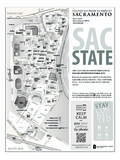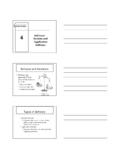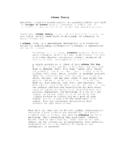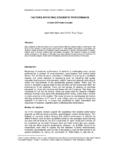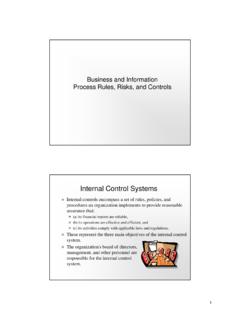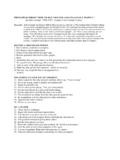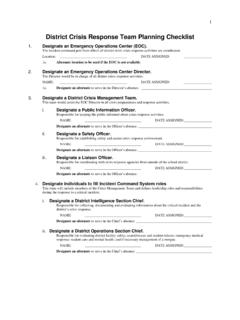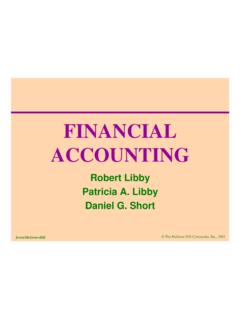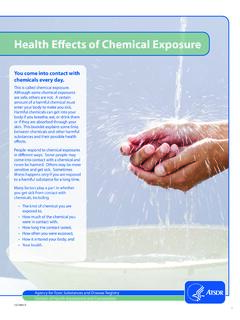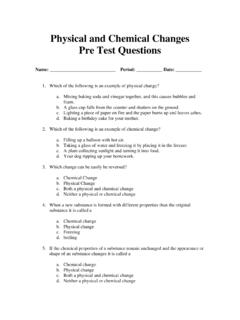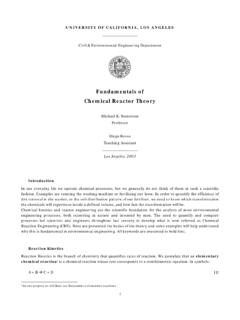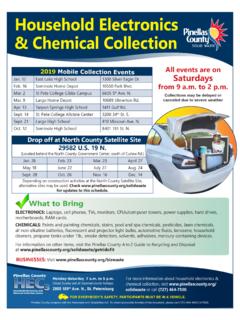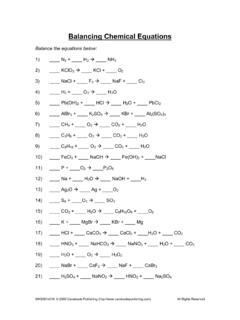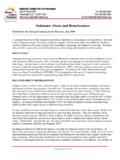Transcription of Chemical Kinetics Reaction Rates
1 1 Reaction Rates : Reaction Rate:The change in the concentration of a reactant or a product with time (M/s).Reactant Products A B()change in number of moles of BAverage ratechange in timemoles of Bt= = [A]Rate t= [B] t=Since reactants go away with time: Chemical Kinetics2 Consider the decomposition of N2O5to give NO2and O2: 2N2O5(g) 4NO2(g) + O2(g)reactants decrease with timeproducts increase with time32N2O5(g) 4NO2(g) + O2(g)From the graph looking at t = 300 to 400 O =9 10 Ms100s = NO = 10 Ms100s = N O = 10 Ms100s = Why do they differ?Recall:To compare the Rates one must account for the O =9 10 Ms9 10 Ms11 = 51612 Rate NO = 10 10 M14s = 516125 Rate N O = 10 1012Ms = Now they Now they agree!
2 Agree! Reaction Rate and StoichiometryaA+ bB cC+ dD[][][][]AB11abCDRatett11cdtt ==== In general for the Reaction :4 The Reaction rate law expressionrelates the rate of a Reaction to the concentrations of the concentration is expressed with an order (exponent).The rate constant converts the concentration expression into thecorrect units of rate (Ms 1). (It also has deeper significance, which will be discussed later)For the general Reaction :For the general Reaction :Rate Law & Reaction OrderaA+ bB cC+ dDxand yare the reactant orders determined from yare NOTthe stoichiometric = k [A] [B] 5 The Overall Orderof a Reaction is the sum of the individual orders:Rate (Ms 1) = k[A][B]1/2[C]2 Overall order:1 + + 2 = = 7/2 or seven halves ordernote:when the order of a Reaction is 1 (first order) no exponent is for the rate constant.
3 The units of a rate constant will change depending upon the overall units of rate are always M/s or Ms 1To find the units of a rate constant for a particular rate law, simply divide the units of rate by the units of molarity in the concentration term of the rate law. Rate (Ms 1) = k[A] 1storder11 Msk(units)sM ==6time (s)Instantaneous rate (tangent line)Y[concentration]Average Rate Xtime = Reaction Ratesconcentration (M)Rules of logarithmslog (1) = 0log (10) = 1log (100) = 2 Log (10x) = xln (1) = 0ln (e) = 1ln (ex) = xlog Ax= xlog Aln Ax= xln AxxxAA Aloglogx logBB B == log(AB) = log A + log BAloglog A log BB = 7 The Reaction of nitric oxide with hydrogen at 1280 C is: Determining Reaction Order.
4 The Method of Initial Rates2NO(g) + 2H2(g) N2(g) + 2H2O(g)From the following data, determine the rate law and rate Rate (M/min)[H2]o(M)[NO]o(M)RunRate(M/min) = k [NO]x[H2]yThe rate law for the Reaction is given by:2NO(g) + 2H2(g) N2(g) + 2H2O(g)Taking the ratio of the Rates of runs 3 and 1 one finds: Rate(3)Rate(1)=xy(3)2 (3)xy(1)2 (1)k [NO] [H ] k [NO] [H ] / / min=xyxyk [ ] [ ] k [ ] [ ]yy[ ][ ]=2 =yy[ ][ ]= = = ()y log 2log 2=y = 1 Rate(1)Rate(2)=xy(1)2 (1)xy(2)2 (2)k [NO] [H ] k [NO] [H ] [ ] [ ] k [ ] [ ]Now that y is known, we may solve for x in a similar manner:124=x1123 x1128 = 11xloglog28 = x = 3 The Rate Law is:Rate(M/min) = k [NO]3[H2]To find the rate constant, choose one set of data and solve:()() ()() ()() M= = 9 Integrated Rate Laws:time dependence of concentrationFor a first order process, the rate law can be written:A products1[A]Rate(Ms )k[A]t = = This is the average rate If one considers the infinitesimal changes in concentration and time the rate law equation becomes:1d[A]Rate(Ms )k[A]dt = =o[A]t[A]0d[A]kdt[A]= where [A] = [A]oat time t = 0and [A] = [A] at time t = tThis is the instantaneous rate Integrating in terms of d[A] and dt.
5 O[A]t[A]0d[A]kdt[A]= o[A]lnkt[A] = kto[A]e[A] =Taking the exponent to each side of the equation:orkto[A] [A] e =Conclusion:Conclusion:The concentration of a reactant governed by first order Kinetics falls off from an initial concentration exponentially with a first order process:A productsWhenever the conc. of a reactant falls off exponentially, the Kinetics follow first [A] [A] e =A plot of ln[A] versus time (t) is a straight line with slope -kand intercept ln[A]o()ktoln [A] [A] e =Determining the Rate constant for a first order processTaking the log of the integrated rate law for a first order process we find:oln[A] ln[A]k t= 11 Example:The rate of decomposition of azomethane (C2H6N2) was studied by monitoring the partial pressure of the reactant as a function of if the data below support a first order Reaction .
6 Calculate the rate constant for the (s)P (mmHgln (P)0284 of lnP vs. timey = + = (s)ln Pk = Half-Life12 Reaction Half-life:Half-life is the time taken for the concentration of a reactant to drop to half its original [A][A]2=For a first order process the half life (t ) is found mathematically from:[][]0(1) ln Aktln A= +[][]0(2) ln Aln Akt = []0A(3) lnkt[A] = []0A(4) lnkt[A] = []0102A(5) lnkt[A]2 = 12ln certain Reaction proceeds through t first order half-life of the Reaction is 180 percent of the initial concentration remains after 900s?Step 1: Determine the magnitude of the rate constant, 2ln == =kto[A]e[A] = s 900 so[A]e[A] == the integrated rate law, substituting in the value of k and 900s we find:Since the ratio of [A] to [A]0represents the fraction of [A]othat remains, the % is given by: 100 = a Second Order Process:A ProductsRate = k[A]212d[A]Rate(Ms )k[A]dt = =Integrating as before we find:[][]011ktAA=+A plot of 1/[A] versus t is a straight line with slope kand intercept 1/[A]0 For a second order Reaction , a plot of ln[A] vs.)
7 Tis not linearnot linear.[][]011ktAA=+Non linearity indicates that the Reaction is not first = k (rate constant)14 Half-life for a second-order reactionUnlike a first order Reaction , the rate constant for a second order process depends on and the initial concentration of a reactant.[][]t011ktAA=+[][]t01AA2= at the half life,Substituting and solving,[]1/ 201tkA=If [NOBr]o= 10-3M, how much NOBr will be left after a Reaction time of 10 minutes?Determine the half-life of this :The reaction2 NOBr (g) 2 NO (g) + Br2(g)is a second order Reaction with respect to NOBr. k= M-1 s-1at []t1 NOBr=[][]t011ktNOBrNOBr=+-1-1( Ms ) (600 s) 10 M + [] 10 MNOBr= [] 10 M = SOLUTION:One can solve for the amount of NOBr after 10 minutes by substituting the given data into the integrated rate law for a second-order Reaction .
8 (Second Order)To determine the half-life for this Reaction , we substitute the initial concentration of NOBr and the rate constant for the Reaction into the equation for the half-life of a second-order 2t= Ms ( 10 M) 160 s=[]1/ 201tkA=16 The ArrheniusEquation:Temperature dependence of the Rate ConstantMost reactions speed up as temperature increases. (example:food spoils when not refrigerated.)kf(T)=Where f is some magnitude of a first order rate constant is seen to increaseexponentially with an increase in (T)k(T)e Therefore one can Therefore one can conclude that:conclude that:17 Why would k (along with the rate) increase with temperature?Let s go back to Kinetic Molecular Theoryto Collision Model:Also, the more molecules present, the greater the probability ofcollision and the faster the Reaction rateshould increasewith an increase in the concentration of reactant molecules.
9 In order for molecules to react they must , the greater the number of collisions the faster the temperature increases, the molecules move faster and the collision frequency Reaction rateshould increasewith an increase in Energy(1) In order to form products, bonds must be broken in the reactants.(2) Bond breakage requires energy.(3) Molecules moving too slowly, with too little kinetic energy,don t react when they collide. The Activation energy, Ea, is the minimum energy required to initiate a Chemical specific to a particular Reaction . Arrhenius:Molecules must posses a minimum amount of energy to react. Why?18N2O(g) + O2(g) N2(g) + NO2(g)Consider the Reaction :The progress of a Reaction can be described by a Reaction CoordinateReactantsProductsRecall for KMT that the temperature for a system of particles isdescribed by a distribution.
10 At higher temps, more particles have enough energy to go over the > EaE < EaSince the probability of a molecule reacting increases, the rate factors into the equationThe orientation of a molecule during collision can have a profound effect on whether or not a Reaction collisions do not lead to Reaction even if there is sufficient Arrhenius EquationArhenius discovered that most Reaction -rate data obeyed an equation based on three factors:(1) The number of collisions per unit time.(2) The fraction of collisions that occur with the correct orientation.(3) The fraction of the colliding molecules that have an energy greater than or equal to these observations Arrhenius developed the aptly named Arrhenius equationArrhenius equationArrhenius equationaERTkAe =Both Aand Eaare specific to a given the rate constantEais the activation energyRis the ideal-gas constant ( J/Kmol)Tis the temperature in KAAis known the frequencyfrequencyor prepre exponential factorexponential factorIn addition to carrying the units of the rate constant, A relates to the frequency of collisions and the orientation of a favorable collision probabilityDetermining the Activation EnergyEamay be determined experimentally.
